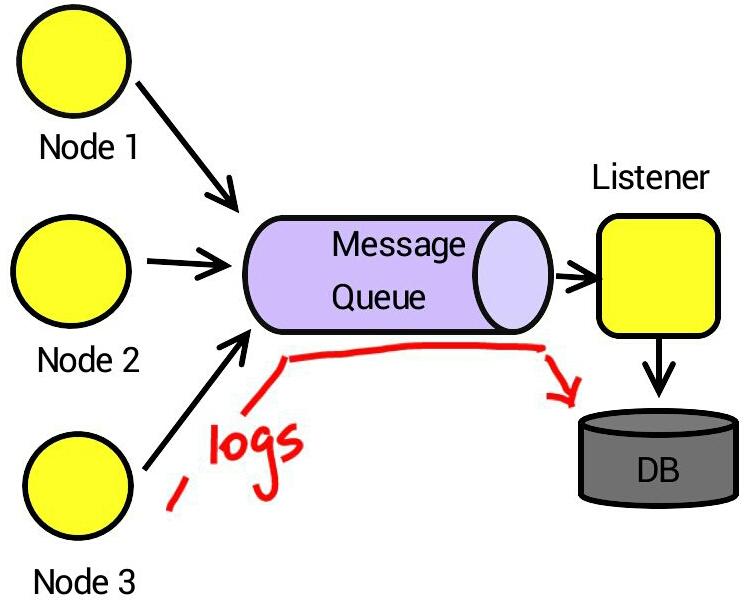使用Log4j、ActiveMQ和Spring實(shí)現(xiàn)異步日志
我的團(tuán)隊(duì)和我正在創(chuàng)建一個(gè)由一組RESTful JSON服務(wù)組成的服務(wù)平臺(tái),該平臺(tái)中的每個(gè)服務(wù)在平臺(tái)中的作用就是分別提供一些獨(dú)特的功能和/或數(shù)據(jù)。由于平臺(tái)中產(chǎn)生的日志四散各處,所以我們想,要是能將這些日志集中化處理一下,并提供一個(gè)能夠讓我們查看、過濾、排序和搜索我們所有的日志的基本型的日常查看工具就好了。我們還想讓我們的日志是異步式的,因?yàn)槲覀兛刹幌朐趯懭罩镜臅r(shí)候(比方說,可能會(huì)將日志直接寫入數(shù)據(jù)庫(kù)),讓我們提供的服務(wù)因?yàn)閷懭罩径鴷簳r(shí)被阻擋住。

實(shí)現(xiàn)這個(gè)目標(biāo)的策略非常簡(jiǎn)單明了。
- 安裝ActiveMQ
- 創(chuàng)建一個(gè)log4j的日志追加器,將日志寫入隊(duì)列(log4j自帶了一個(gè)這樣的追加器,不過現(xiàn)在讓我們自己來寫一個(gè)吧。)
- 寫一個(gè)消息偵聽器,從MQ服務(wù)器上所設(shè)置的JMS隊(duì)列中讀取日志并將日志持久化
下面讓我們分步來看這個(gè)策略是如何得以實(shí)現(xiàn)的。
安裝ActiveMQ
安裝一個(gè)外部的ActiveMQ服務(wù)器簡(jiǎn)單極了。這個(gè)鏈接http://servicebus.blogspot.com/2011/02/installing-apache-active-mq-on-ubuntu.html是在Ubuntu上安裝ActiveMQ的一個(gè)非常棒的指南。你還可以選擇在你的應(yīng)用中嵌入一個(gè)消息代理,采用Spring就可以非常輕松實(shí)現(xiàn)。 我們將在后文中詳談具體的實(shí)現(xiàn)方法。
創(chuàng)建一個(gè)Lo4j的JMS日志追加器
首先,我們來創(chuàng)建一個(gè)log4j的JMS日志追加器。log4j自帶了一個(gè)這樣的追加器(該追加器沒有將日志寫入一個(gè)隊(duì)列,而是寫給了一個(gè)話題)
- import javax.jms.DeliveryMode;
- import javax.jms.Destination;
- import javax.jms.MessageProducer;
- import javax.jms.ObjectMessage;
- import javax.jms.Session;
- import org.apache.activemq.ActiveMQConnectionFactory;
- import org.apache.log4j.Appender;
- import org.apache.log4j.AppenderSkeleton;
- import org.apache.log4j.Logger;
- import org.apache.log4j.PatternLayout;
- import org.apache.log4j.spi.LoggingEvent;
- /**
- * JMSQueue appender is a log4j appender that writes LoggingEvent to a queue.
- * @author faheem
- *
- */
- public class JMSQueueAppender extends AppenderSkeleton implements Appender{
- private static Logger logger = Logger.getLogger("JMSQueueAppender");
- private String brokerUri;
- private String queueName;
- @Override
- public void close() {
- }
- @Override
- public boolean requiresLayout() {
- return false;
- }
- @Override
- protected synchronized void append(LoggingEvent event) {
- try {
- ActiveMQConnectionFactory connectionFactory = new ActiveMQConnectionFactory(
- this.brokerUri);
- // Create a Connection
- javax.jms.Connection connection = connectionFactory.createConnection();
- connection.start();np
- // Create a Session
- Session session = connection.createSession(false,Session.AUTO_ACKNOWLEDGE);
- // Create the destination (Topic or Queue)
- Destination destination = session.createQueue(this.queueName);
- // Create a MessageProducer from the Session to the Topic or Queue
- MessageProducer producer = session.createProducer(destination);
- producer.setDeliveryMode(DeliveryMode.NON_PERSISTENT);
- ObjectMessage message = session.createObjectMessage(new LoggingEventWrapper(event));
- // Tell the producer to send the message
- producer.send(message);
- // Clean up
- session.close();
- connection.close();
- } catch (Exception e) {
- e.printStackTrace();
- }
- }
- public void setBrokerUri(String brokerUri) {
- this.brokerUri = brokerUri;
- }
- public String getBrokerUri() {
- return brokerUri;
- }
- public void setQueueName(String queueName) {
- this.queueName = queueName;
- }
- public String getQueueName() {
- return queueName;
- }
- }
第37行: log4j將一個(gè)LoggingEvent對(duì)象作為參數(shù)對(duì)append方法進(jìn)行調(diào)用,這個(gè)LoggingEvent對(duì)象表示了對(duì)logger的一次調(diào)用,它封裝了每一個(gè)日志項(xiàng)的所有信息。
第41和42行:將指向JMS的uri作為參數(shù),創(chuàng)建一個(gè)連接工廠對(duì)象,在我們的情況下,該uri指向的是我們的ActiveMQ服務(wù)器。
第45, 46和49行: 我們同JMS服務(wù)器建立一個(gè)連接和會(huì)話。會(huì)話有多種打開模式。在Auto_Acknowledge模式的會(huì)話中,消息的應(yīng)答會(huì)自動(dòng)發(fā)生。Client_Acknowledge 模式下,客戶端需要對(duì)消息的接收和/或處理進(jìn)行顯式地應(yīng)答。另外還有兩種其它的模式。有關(guān)細(xì)節(jié),請(qǐng)參考文檔http://download.oracle.com/javaee/1.4/api/javax/jms/Session.html
第52行: 創(chuàng)建一個(gè)隊(duì)列。將隊(duì)列的名字作為參數(shù)發(fā)送給連接
下面讓我們看看這里面發(fā)生了什么事情。
第19行:We我們實(shí)現(xiàn)了的Log4J日志追加器接口,該接口要求我們實(shí)現(xiàn)三個(gè)方法:requiresLayout, close和append。我們將暫時(shí)簡(jiǎn)化處理過程,實(shí)現(xiàn)所需的append方法。在對(duì)logger進(jìn)行調(diào)用時(shí)這個(gè)方法就會(huì)被調(diào)用。
第56行: 我們將發(fā)送模式設(shè)置為Non_Persistent。另一個(gè)可選的模式是Persistent ,在這種模式下,消息會(huì)持久化到一個(gè)持久性存儲(chǔ)系統(tǒng)中。持久化模式會(huì)降低系統(tǒng)速度,但能增加了消息傳遞的可靠性。
第58行: 這行我們做了很多事。首先我將一個(gè)LoggingEvent對(duì)象封裝到了一個(gè)LoggingEventWrapper對(duì)象之中。這么做是因?yàn)?em>LoggingEvent對(duì)象有一些屬性不支持序列化,另外還有一個(gè)原因是我想記錄一些額外的信息,比如IP地址和主機(jī)名。接下來,使用JMS的會(huì)話對(duì)象,我們把一個(gè)對(duì)象(LoggingEventWrapper對(duì)象)做好了發(fā)送前的準(zhǔn)備。
第61行: 我將該對(duì)象發(fā)送到了隊(duì)列中。
下面所示是LoggingEventWrapper的代碼。
- import java.io.Serializable;
- import java.net.InetAddress;
- import java.net.UnknownHostException;
- import org.apache.log4j.EnhancedPatternLayout;
- import org.apache.log4j.spi.LoggingEvent;
- /**
- * Logging Event Wraps a log4j LoggingEvent object. Wrapping is required by some information is lost
- * when the LoggingEvent is serialized. The idea is to extract all information required from the LoggingEvent
- * object, place it in the wrapper and then serialize the LoggingEventWrapper. This way all required data remains
- * available to us.
- * @author faheem
- *
- */
- public class LoggingEventWrapper implements Serializable{
- private static final String ENHANCED_PATTERN_LAYOUT = "%throwable";
- private static final long serialVersionUID = 3281981073249085474L;
- private LoggingEvent loggingEvent;
- private Long timeStamp;
- private String level;
- private String logger;
- private String message;
- private String detail;
- private String ipAddress;
- private String hostName;
- public LoggingEventWrapper(LoggingEvent loggingEvent){
- this.loggingEvent = loggingEvent;
- //Format event and set detail field
- EnhancedPatternLayout layout = new EnhancedPatternLayout();
- layout.setConversionPattern(ENHANCED_PATTERN_LAYOUT);
- this.detail = layout.format(this.loggingEvent);
- }
- public Long getTimeStamp() {
- return this.loggingEvent.timeStamp;
- }
- public String getLevel() {
- return this.loggingEvent.getLevel().toString();
- }
- public String getLogger() {
- return this.loggingEvent.getLoggerName();
- }
- public String getMessage() {
- return this.loggingEvent.getRenderedMessage();
- }
- public String getDetail() {
- return this.detail;
- }
- public LoggingEvent getLoggingEvent() {
- return loggingEvent;
- }
- public String getIpAddress() {
- try {
- return InetAddress.getLocalHost().getHostAddress();
- } catch (UnknownHostException e) {
- return "Could not determine IP";
- }
- }
- public String getHostName() {
- try {
- return InetAddress.getLocalHost().getHostName();
- } catch (UnknownHostException e) {
- return "Could not determine Host Name";
- }
- }
- }
#p#
消息偵聽器
消息偵聽器會(huì)對(duì)隊(duì)列(或話題)進(jìn)行“偵聽”。一旦有新消息添加到了隊(duì)列中,onMessage 方法就會(huì)得到調(diào)用。
- import javax.jms.JMSException;
- import javax.jms.Message;
- import javax.jms.MessageListener;
- import javax.jms.ObjectMessage;
- import org.apache.log4j.Logger;
- import org.springframework.beans.factory.annotation.Autowired;
- import org.springframework.stereotype.Component;
- @Component
- public class LogQueueListener implements MessageListener
- {
- public static Logger logger = Logger.getLogger(LogQueueListener.class);
- @Autowired
- private ILoggingService loggingService;
- public void onMessage( final Message message )
- {
- if ( message instanceof ObjectMessage )
- {
- try{
- final LoggingEventWrapper loggingEventWrapper = (LoggingEventWrapper)((ObjectMessage) message).getObject();
- loggingService.saveLog(loggingEventWrapper);
- }
- catch (final JMSException e)
- {
- logger.error(e.getMessage(), e);
- } catch (Exception e) {
- logger.error(e.getMessage(),e);
- }
- }
- }
- }
第23行: 檢查從隊(duì)列中拿到的對(duì)象是否是ObjectMessage的實(shí)例
第26行: 從消息中提取出LoggingEventWrapper對(duì)象
第27行: 調(diào)用服務(wù)方法將日志持久化
Spring配置
- <?xml version="1.0" encoding="UTF-8"?>
- <beans xmlns="http://www.springframework.org/schema/beans" xmlns:xsi="http://www.w3.org/2001/XMLSchema-instance" xmlns:p="http://www.springframework.org/schema/p" xmlns:context="http://www.springframework.org/schema/context" xmlns:jms="http://www.springframework.org/schema/jms" xmlns:amq="http://activemq.apache.org/schema/core" xmlns:aop="http://www.springframework.org/schema/aop" xsi:schemaLocation="http://www.springframework.org/schema/beans http://www.springframework.org/schema/beans/spring-beans-3.0.xsd http://www.springframework.org/schema/context http://www.springframework.org/schema/context/spring-context-3.0.xsd http://www.springframework.org/schema/aop http://www.springframework.org/schema/aop/spring-aop-3.0.xsd http://www.springframework.org/schema/jms http://www.springframework.org/schema/jms/spring-jms-3.0.xsd http://activemq.apache.org/schema/core http://activemq.apache.org/schema/core/activemq-core-5.5.0.xsd">
- <!-- lets create an embedded ActiveMQ Broker -->
- <!-- uncomment the tag below only if you need to create an embedded broker -->
- <!-- amq:broker useJmx="false" persistent="false">
- <amq:transportConnectors>
- <amq:transportConnector uri="tcp://localhost:61616" />
- </amq:transportConnectors>
- </amq:broker-->
- <!-- ActiveMQ destinations to use -->
- <amq:queue id="destination" physicalName="logQueue" />
- <!-- JMS ConnectionFactory to use, configuring the embedded broker using XML -->
- <amq:connectionFactory id="jmsFactory" brokerURL="tcp://localhost:61616" />
- <bean id="connectionFactory" class="org.springframework.jms.connection.CachingConnectionFactory">
- <constructor-arg ref="jmsFactory" />
- <property name="exceptionListener" ref="JMSExceptionListener" />
- <property name="sessionCacheSize" value="100" />
- </bean>
- <!-- Spring JMS Template -->
- <bean id="jmsTemplate" class="org.springframework.jms.core.JmsTemplate">
- <constructor-arg ref="connectionFactory" />
- </bean>
- <!-- listener container definition using the jms namespace, concurrency
- is the max number of concurrent listeners that can be started -->
- <jms:listener-container concurrency="10">
- <jms:listener id="QueueListener" destination="logQueue" ref="logQueueListener" />
- </jms:listener-container>
- </beans>
第5到9行: 使用代理標(biāo)簽建立一個(gè)嵌入式消息代理。既然我用的是外部消息代理,所以我就不需要它了。
第12行: 給出你想要連接的隊(duì)列的名字
第14行: 代理服務(wù)器的URI
第15到19行: 連接工廠的設(shè)置
第26到28行: 消息偵聽器的設(shè)置,這里可以指定用于從隊(duì)列中讀取消息的并發(fā)現(xiàn)線程的個(gè)數(shù)
當(dāng)然,上面的例子做不到讓你能夠拿來就用。你還需要包含所有的JMS依賴庫(kù)并實(shí)現(xiàn)完成日志持久化任務(wù)的服務(wù)。但是,我希望本文能夠?yàn)槟闾峁┮粋€(gè)相當(dāng)不錯(cuò)的思路。
英文原文:Asynchronous logging using Log4j, ActiveMQ and Spring
譯文鏈接:http://www.oschina.net/translate/asynchronous-logging-using-log4j-activemq-and-spring



































